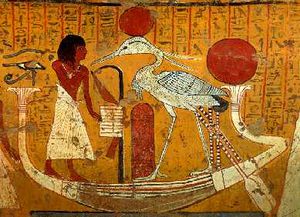燃える鳥
死と再生を繰り返し、死ぬ際に燃え上がる鳥
目次
ベンヌ[編集]
ベンヌ(Bennu)、ベヌウ、ベヌとは、エジプト神話に伝わる不死の霊鳥。太陽や再生の信仰と結びついている。
エジプト語の「立ち上がる者(ウェベン)」が由来とされる。「鮮やかに舞い上がり、そして光り輝く者」、「ラーの魂」、「自ら生まれた者」または、「記念祭の主」などの肩書きを持つ。
主に長い嘴をした黄金色に輝く青鷺で、他に爪長鶺鴒(つめながせきれい)、赤と金の羽がある鷲とも言う。稀なケースでは、鷺の頭をした人間の姿で表された。
太陽信仰と関連付けられたイシェドの木(ギリシアでは、ペルセア)にとまる聖鳥アトゥム、ラー、オシリスの魂であるとも考えられている。
ベンヌは自らを創造した存在で、世界の創造に一役買ったとされている。アトゥムあるいは、ラーは、この世の始めに混沌または、原初の海ヌンからベンヌの姿で(自生的に)誕生し、原初の丘「タァ・セネン」もしくは、「ベンベン」の上に舞い降りたという。あるいは、原初の海に沈んでいた太陽(の卵)が原初の丘に揚がった時にベンヌが太陽を抱いて暖めて孵化させたともされる。なお、この原初の丘を神格化したものがタテネンである。この世の最初に誕生した鳥である事からベンヌの鳴き声により、この世の時間が開始されたともされる。
太陽と同じように毎朝生まれ夕暮れと共に死んで次の朝に再び生き返るとされた。生と死を繰り返すことからオシリスとも関連付けられた。
ホルス及びギリシアのフェニックスのモデルとなった、も言われる。
Roles[編集]
He was said to be the ba of Ra and to have enabled the creative actions of Atum.[1] The deity was said to have flown over the waters of Nun that existed before creation, landing on a rock and issuing a call that determined the nature of creation. He also was a symbol of rebirth and, therefore, was associated with Osiris.[2]
Some of the titles of Bennu were "He Who Came Into Being by Himself",[1] and "Lord of Jubilees"; the latter epithet referred to the belief that Bennu periodically renewed himself like the sun was thought to do.[2] His name is related to the Egyptian verb wbn, meaning "to rise in brilliance" or "to shine".[1]
Depiction[編集]
テンプレート:Hiero The Pyramid Texts, which date to the Old Kingdom, refer to the 'bnw' as a symbol of Atum, and it may have been the original form of Bennu. In this word the shape of a bird is used that is definitely not a heron, but a small singing bird. The old 'Woerterbuch der Aegyptische Sprache' surmised that this small singing bird might have been a Yellow Wagtail ('Motacilla flava', but no clear reason is given. [1] However, the same bird used in the spelling of a word 'bn.t' in a painted limestone relief wall fragment from the suntemple of the Vth Dynasty king Niuserre from the Old Kingdom, now in the Aegypisches Museum at Berlin (inv.nr. Aeg.Mus. 20038-20039), clearly shows traces of blue-grey paint on much of the body of this bird-sign, so that a different bird species was definitely meant. Shape and colour seem to point rather to a (Mediterranean) Kingfisher (Alcedo atthis) for whom, however, another name was in use: 'hn.t<y'= lit. 'the one of the canal'. Traces of orange(brown)colouring existing on and also outside the chiseled glyph did originally not belong to this particular bird sign. They are caused by natural stains in the white limestone, as the higher lying layer of blue paint on the bird shows as well. The advantage of such bird identification might be, that a Kingfisher flying lowly over watery surfaces and shrieking loudly would be a reasonable mythical example for the creator deity Atum of Heliopolis as having risen from the first dark waters, called Nun, in order to start his creation of the world. If so, this Kingfisher 'bnw' or 'bn.t' is a good match for the mythical and cultic Nilegoose (Eg. 'smn')of the creator deity Amun in later periods, imagined to having been honking loudly in the primeval dark above the still waters in order to bring forth all creation by its voice.テンプレート:Cn
New Kingdom artwork shows Bennu as a huge grey heron with a long beak and a two-feathered crest. Sometimes Bennu is depicted as perched on a benben stone (representing Ra and the name of the top stone of a pyramid) or in a willow tree (representing Osiris). Because of the connection with Osiris, Bennu sometimes wears the Atef crown,[2] instead of the solar disk.
Possible animal model[編集]
In comparatively recent times, a large species of heron, now extinct, lived on the Arabian Peninsula. It shares many characteristics with Bennu. It may have been the animal after which Bennu was modeled by the ancient Egyptians during the New Kingdom.[3]
Worship[編集]

Like Atum and Ra, the Bennu was probably worshipped in their cult center at Heliopolis.[2] The deity also appears on funerary scarab amulets as a symbol of rebirth.[1]
Connection with the Greek phoenix[編集]
The Greek historian Herodotus, writing about Egyptian customs and traditions in the fifth century BC, wrote that the people at Heliopolis described the "phoenix" to him. They said it lived for 500 years before dying, resuscitating, building a funerary egg with myrrh for the paternal corpse, and carrying it to the temple of the Sun at Heliopolis.[4] His description of the phoenix likens it to an eagle with red and gold plumage, reminiscent of the sun.[2]
Long after Herodotus, the theme ultimately associated with the Greek phoenix, with the fire, pyre, and ashes of the dying bird developed in Greek traditions.
The name, "phoenix", could be derived from "Bennu" and its rebirth and connections with the sun resemble the beliefs about Bennu, however, Egyptian sources do not mention a death of the deity.[1]
Chosen as scientific name of the bird[編集]
Remains of a giant, human-sized heron species, thought to have gone extinct around 1500 BC, have been discovered in the United Arab Emirates.[5] That species may have been the animal model for the deity, Bennu, so archaeologist Dr. Ella Hoch from the Geological Museum at Copenhagen University named it the Bennu heron (Ardea bennuides).[6]
Further reading[編集]
- テンプレート:Cite book
- Lecocq, Françoise (2016). "Inventing the Phoenix: A Myth in the making Through Words and Images". In Johnston, Patricia A.; Mastrocinque, Attilio; Papaioannou, Sophia. Animals in Greek and Roman Religion and Myth. Cambridge Scholars Publishing, pp. 449–478.
- Lecocq, Françoise (2019). "L'oiseau bénou-phénix et son tertre sur la tunique historiée de Saqqâra. Une interprétation nouvelle" テンプレート:In lang, ENiM (Égypte nilotique et méditerranéenne) 12, 2019, pp. 247–280.
- テンプレート:Cite book
- テンプレート:Cite journal
アペプ[編集]
アペプ(Apep)は、エジプト神話における悪の化身。古代エジプト語での名は他に、アーペプ(アアペプ、Aapep)、アペピ(Apepi)、アピペ(Apipe)、アポペ(Apope)などが挙げられる。古代エジプト語のヒエログリフは、母音を明確に記述しないため本来の発音は、はっきりしない。古典ギリシア語転記であるアポピス(Αποφις, Apophis)でもよく知られる。
概要[編集]
闇と混沌を象徴し、その姿は、主に大蛇として描かれる。蛇は、古代エジプト人にとって身近で畏怖される存在であった。太陽の運行を邪魔するのでラーの最大の敵とされる。
アポピスは、世界が誕生する前のヌンに象徴される原始の水の中から生まれた。世界の秩序が定まる前に生まれたので秩序を破壊しようとすると考えられた。あるいは、もとは、太陽神としての役割を担っていたが、それをラーに奪われたため彼を非常に憎み、敵対するようになった。ここからラーの乗る太陽の船の運航を邪魔し、日食を起こすと考えられた。
冥界に捕えられており、ここを死者の魂が通ると襲う。死者の書 (古代エジプト)は、アポピスから身を守る方法が描かれているとされた。またラーの乗る太陽の船が通過する時、セトが船を守りアポピスを打ち倒すため天敵といわれている。しかし時代が下ると、その邪悪さのためにセトと同一視された。
エスナではラーとアポピスはネイト[7]から生まれ、ラーは正常な形で生まれたが、アポピスは口から吐き出された、とされる。アポピスは道をふさいで朝、日が昇るのを邪魔する[8]。
参考文献[編集]
- Wikipedia:アペプ
関連項目[編集]
関連リンク[編集]
参照[編集]
- ↑ 1.0 1.1 1.2 1.3 1.4 1.5 テンプレート:Cite book
- ↑ 2.0 2.1 2.2 2.3 2.4 テンプレート:Cite book
- ↑ テンプレート:Cite conference
- ↑ テンプレート:Cite journal
- ↑ WONDERS OF THE UNITED ARAB EMIRATES.{{{date}}} - via {{{via}}}.
- ↑ GIANT BIRDS FROM THE TOMBS OF THE PHARAOHS.31 May 2016 - via {{{via}}}.
- ↑ エスナの守護神。クヌムの妻とされていたと思われる。ネイトそのものは紀元前3100年頃より信仰された。プロクロス(412年-485年)は、サイスの現存しないネイトの神殿の至聖所に次の碑文が刻まれていたと記している。「私はかつてあり、今もあり、これからもある全てである。そして私のヴェールを人間が引き上げたことはない。私がもたらした果実は太陽である。(trans. Thomas Taylor, Proclus , The Commentaries of Proclus on the Timaeus of Plato, in Five Books, A.J. Valpy, year;1820, page = 82, url = http://books.google.com/books?&pg=PA82&id=Qh9dAAAAMAAJ&ots=0h_azc_OV5#PPA82 )」。ヘロドトスによれば「ランプ祭」(Feast of Lamps)と呼ばれる大きな祭りが毎年開催され、戸外に一晩中多数の明かりを灯したという。
- ↑ 世界神話大辞典、イヴ・ボンヌフォア著、金光仁三郎訳、大修館書店、110p
